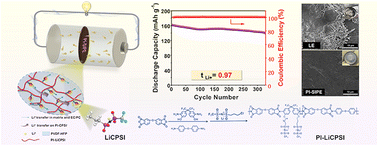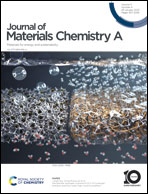A single-ion gel polymer electrolyte based on polyimide grafted with lithium 3-chloropropanesulfonyl (trifluoromethanesulfonyl) imide for high performance lithium ion batteries†
Abstract
With a high lithium-ion transfer number (tLi+), single-ion gel polymer electrolytes can inhibit the growth of lithium dendrites and improve cycling performance effectively, and have attracted much attention. Due to high thermal stability, hydroxyl-containing polyimide (PI-OH) was prepared to be applied as the backbone, and grafted with lithium 3-chloropropanesulfonyl(trifluoromethanesulfonyl)imide (LiCPSI) to synthesize the single-ion polymer (PI-LiCPSI), which was further compounded with poly(vinylidene fluoride)-(hexafluoropropylene) (PVDF-HFP) to obtain polyimide single-ion polymer electrolyte (PI-SIPE). Its shrinkage rate was only about 0.3% after being kept at 200 °C for 0.5 h. And the tensile strength and Young's modulus were 30 MPa and 1.72 GPa, respectively, due to the rigid PI main chain and the strong interface between PVDF-HFP and PI-LiCPSI. The PI-SIGPE obtained by addition of EC/DMC into PI-SIPE presented both excellent ion transport capacity and electrochemical stabilities, with a high (tLi+) (0.97), a wide electrochemical window (5.2 V), and an ionic conductivity of 1.4 × 10−4 S cm−1 at 30 °C. The initial discharge capacity of the Li/PI-SIGPE/LFP battery can be as high as 161 mA h g−1 at 0.2C, and the capacity retention rate was more than 90% after 330 cycles. Predictably, PI-SIGPEs with superior synthetic performances have great application prospects in solid state lithium ion batteries (SSLIBs).

- This article is part of the themed collection: Journal of Materials Chemistry A HOT Papers


 Please wait while we load your content...
Please wait while we load your content...